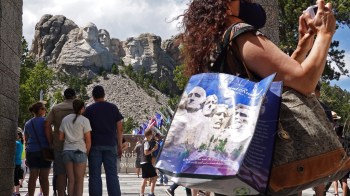Louisiana alligator hunters set to reel in profits
The season to hunt wild alligators in the Bayou State opens Wednesday. The one-month open season is big business for fishermen and people like Tony Howard, a nuisance alligator hunter. He legally hunts alligators year-round. Inside the walk-in cooler behind his house in rural Sarepta, La., is a mound of neatly coiled and cured alligator skins ready for market.
“Whole alligators are kept in here until they are processed,” Howard says. “This keeps them at a constant temperature, and it gives me more time to skin them.”
Howard runs a processing business on the side. He’ll skin dozens of alligators this season and then sell the hides at the best price. He says the cost of a whole alligator could jump 10 percent over last year. A 10-footer might fetch about $400.
“We’re not out to make a killing,” he says. “We’re not out to retire off of it. This is just a commodity, and you have to shop it, and try to get the best price you can out of the commodity.”
That’s attracted more alligator buyers to the market, according to Howard. About 34,000 wild alligators will be harvested from Louisiana this year. Meanwhile, luxury goods companies are buying alligator and crocodile farms and tanneries around the world. They want more control over their raw material. Christy Plott Redd, vice president of sales at American Tanning and Leather in Griffin, Ga., says this is good for business.
“Luxury brands that buy tanneries typically use alligator and crocodile every season, year after year, and it lends stability to our industry and also increases demand for the skins,” Redd says.
Demand is strong, and Redd is trying to get an edge over other buyers. Her tannery is awarding $10,000 to the fisherman who brings her the biggest catch and all their alligators for this season — regardless of what they look like. Like grading diamonds, according to Redd, there are good ones and bad ones. Her tannery will eat the cost on ones that aren’t perfect enough for her fashion house customers.
“Maybe less than 10 percent of the alligators that we buy are really first-grade skins. You sell those at a premium price,” Redd says. “But the ones that are bad, they stack up on your shelves for years and years.”
A typical handbag may take two or three alligators. European craftsmanship drives up the price. There’s also a thriving secondary market for collectors of alligator handbags, according to Thomai Serdari, who teaches luxury marketing at NYU’s Stern School of Business.
“There is a constant exchange in a very small group of people who tend to actually increase the prices,” Serdari says. “We have alligator bags that have hit the market that go as high as $130,000, which is absurd.”
Soaring prices are driven by a strong demand from luxury consumers in Asia, Serdari says. But in bayou country, gator hunter Tony Howard just hopes that temperatures remain summerlike so the big ones bite, and the season isn’t a bust.
“The only time that I enjoy this is whenever I’m leaving the buyer with check in hand,” Howard says. “The rest of this is all a job.”
His part is not glamorous, but it pays the bills.
There’s a lot happening in the world. Through it all, Marketplace is here for you.
You rely on Marketplace to break down the world’s events and tell you how it affects you in a fact-based, approachable way. We rely on your financial support to keep making that possible.
Your donation today powers the independent journalism that you rely on. For just $5/month, you can help sustain Marketplace so we can keep reporting on the things that matter to you.


















